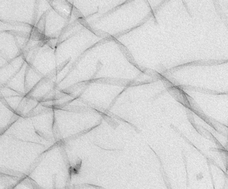The incorporation of a single β-aminoethane sulfonyl amide moiety in a highly amyloidogenic peptide sequence resulted in a complete loss of amyloid fibril formation. Instead, supramolecular folding morphologies were observed. Subsequent chemoselective N-alkylation of the sulfonamide resulted in amphiphilic peptide-based hydrogelators. It was found that variation of merely the alkyl chain induced a dramatic variation in aggregation motifs such as helical ribbons and tapes, ribbons progressing to closed tubes, twisted lamellar sheets and entangled/branched fibers.

